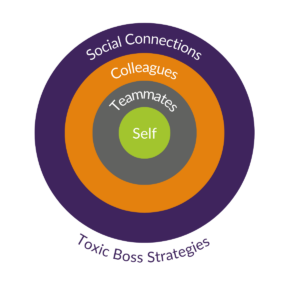In this series on toxic work environments, we’ve talked about the five different ways that your work might be harmful to your physical or psychological safety. I also offered up options for what you might do to escape a bad situation by quitting your boss or your role instead of quitting your organization.
But sometimes, the right decision is to stay right where you are–under the thumb of a toxic boss. Maybe it’s the best option. Maybe it’s your only option.
Regardless, if you’re settling in for at least some time with a bad boss, you’re going to need some strategies to help you cope.
Toxic bosses come in many different shapes and sizes. Each type has its own signature and unique set of challenges. While the optimal strategy depends on the nature of your manager’s dysfunction, there are a few general rules you can follow to help you cope with any bad leader. Consider these universal techniques and then see the catalog of specific advice for each type of toxic boss that I’ve included at the bottom.
A Strategy to Deal with Your Toxic Boss
To build your toxic boss strategy, think about your sources of support as concentric circles with you at the center and your broad network of contacts and friends on the outside. Let’s start in the center.

Look Inward: The Self Strategies
The place to start in building a strategy to cope with your horrible boss is in your own head. That’s where the most important action is happening. The stories you tell yourself will determine how much of a negative impact your manager can have on you. Work through these questions, either on your own or with a trusted friend, as a starting point.
Am I overreacting?
It’s easy to take offense when your manager criticizes your work, passes you over for a plum assignment, or spends ages talking to your coworkers while avoiding you. If you start to form a story that your boss doesn’t like you, you’ll be looking for all the evidence to convince yourself that it’s true and ignoring any evidence to the contrary. That’s called the confirmation bias and it’s how our brains work—a bit of a bug in the code.
 To avoid whipping yourself into a froth over interactions that might be relatively minor, find someone you trust and share what you’re experiencing. Be as objective as possible. If it’s an email from your manager that got you worried, ask someone to take a look and see how the message strikes them. If it was an interaction in a meeting, describe what you saw and heard. Share how you’re interpreting the situation and ask, “how else could I interpret this?” or “what do you think she means by this?” or “how worried should I be?”
To avoid whipping yourself into a froth over interactions that might be relatively minor, find someone you trust and share what you’re experiencing. Be as objective as possible. If it’s an email from your manager that got you worried, ask someone to take a look and see how the message strikes them. If it was an interaction in a meeting, describe what you saw and heard. Share how you’re interpreting the situation and ask, “how else could I interpret this?” or “what do you think she means by this?” or “how worried should I be?”
If that trusted ally is on your team, ask if they could pay attention and give you any feedback about your interactions with your manager. They’ll be able to give you a more balanced view and potentially share a few tips about what works and what doesn’t.
If you don’t have someone you can trust, simply keep a record of your interactions by drawing a vertical line down the center of a piece of paper. Record the positive or neutral things on the left and the negative or unpleasant ones on the right. Counteract your confirmation bias by actively looking for evidence for the left side.
If even the most balanced, objective view of your relationship with your boss is that it’s toxic. Move to the next step.
How can I protect my self-esteem?
If your boss doesn’t like you, doesn’t value you, doesn’t think you’re up to the task, you’re going to need to invest effort in protecting your self-esteem. No boss has the right or the power to make you feel bad about yourself.
If your manager says hurtful things about you as a person or your skills or traits, reframe them into statements about your behavior or the situation. For example, if they say, “you’re so sloppy,” reframe it as “I wrote a 2,000-word report and there were two typos.” Labels are more hurtful than behaviors. It’s distressing to think “I’m sloppy” but manageable to think “I left two typos in a report.”
For each hurtful comment, ask for a balancing comment. “I understand that I left two typos in the report. What parts of the report were good that I should repeat next time?” That way, you’re getting some balance in the equation. Most bosses will answer that question. If not, you could ask the same of a colleague or even of yourself. “I left two typos, but this report had way better graphs than I’ve done before.”
Just as Step 1 was about keeping a balanced view of your boss, it’s important to keep a balanced view of yourself, too!
United Front: Teammate Strategies
Enduring a terrible boss is awful but it’s not something you have to do alone. You have other people who are stuck with that terrible boss too!
[Caveat: if your colleagues don’t view your boss as toxic, this might be a case for some more soul-searching. Go back to Step 1 and consider whether there’s more in your control than you thought.]
How can our team keep functioning with a toxic boss?
Many terrible bosses are bad for business: the disorganized, crisis-junkie boss; the conflict-avoidant, can’t-make-a-tough-decision-to-save-their-life boss; and the flip-flopping boss are just a few examples. If you’ve got a bumbling manager, your team is going to have to step in and manage yourselves.
 You can try to do this through official channels like using a meeting to force the point when you’re not aligned or when your manager’s priorities aren’t clear. If you’ve all got one another’s backs, it’s easier to say, “we need to know which of these 7 things you want to be finished first.” Similarly, if you know a colleague will back you up, you can be direct in asking, “last week, we committed to finishing the release of the Alpha project first. Shifting to the Owl project now will stall Alpha. Can we have two weeks to get Alpha done before we move on?”
You can try to do this through official channels like using a meeting to force the point when you’re not aligned or when your manager’s priorities aren’t clear. If you’ve all got one another’s backs, it’s easier to say, “we need to know which of these 7 things you want to be finished first.” Similarly, if you know a colleague will back you up, you can be direct in asking, “last week, we committed to finishing the release of the Alpha project first. Shifting to the Owl project now will stall Alpha. Can we have two weeks to get Alpha done before we move on?”
In some cases, the manager will follow your cue and do a better job. Sadly, it’s possible that broaching these topics will just make matters worse. In that case, establish a line of communication among your teammates that doesn’t include the boss. If you can’t get your manager to prioritize, have a huddle after the meeting to agree on what you’re all going to work on first. If the manager hasn’t defined the problem you’re solving or hasn’t assigned who is responsible, do it for them. Become a self-managing team. The point is not to be insubordinate or to act against the instructions of your boss. The point is to make up for it when your boss gives you no instructions.
How can my teammates support each other?
In addition to stepping in to lead the team together, you and your colleagues can also form a strong community and a safe place for people to vent, ask for help, or just check their sanity. Become a safe person that your colleagues can talk to without fear of judgment or concern that you’ll spill what they said to the boss. Reach out with the odd meme or puppy video when you can tell someone’s having a rough day. Establish a “safe word” that people can use to indicate that they need support in a meeting, such as, “Edwards, what do you reckon?” where “reckon” means I really need you to take the heat off me for a minute.
Early in my career, I endured a boss with wildly unrealistic expectations and tumultuous mood swings. My teammates and I all recognized her behavior and banded together to support one another and to get the job done as best we could. They made it bearable and often fun. Twenty-five years later, I’m still dear friends with many of those coworkers. Relationships forged in fire, I guess.
Bolster Your Network: Colleague Strategies
In addition to your efforts to stabilize the experience within your team, it’s also valuable to build bridges to people outside your team. If your toxic boss takes the whole team down with them, you want an escape route.
How can I get more support?
Here are a few tactics you can use:
- Reconnect with former teammates or managers who are now in other parts of the organization. Catch up, share what you’re working on, take interest in their priorities. Make sure you are on their radar.
- Volunteer for cross-functional projects that will provide exposure and opportunity beyond your current team. These projects will not only improve your visibility, but might also offer a meaningful place to contribute, access to feedback and coaching, and some respite from your normal tribulations.
- Participate in activities outside of your role. Join the company softball team. Volunteer for the fundraising campaign. Use any opportunity to be seen as a good corporate citizen.
If no one knows who you are, you’re more vulnerable to the whims of your toxic boss. That might just mean that your boss can toy with you. It could also mean that no one will bat an eyelash when your manager tries to fire you. The more ties you have into the organization and the stronger your reputation as a great team player, the safer you are. Just be 100% committed to taking the high road. Never gossip or complain about your boss.
Is it safe to ask HR for help?
One source of recourse for a truly terrible boss is to speak with Human Resources. In my experience, this is usually a safe and worthwhile option if you handle it the right way. HR professionals get more than their fair share of whining, complaining people and that approach is as likely to get you labeled as a toxic employee as it is to raise the alarm bells about your toxic boss.
Instead, approach HR in search of assistance and advice. State objectively what you’re experiencing and keep the conversation focused on you.
“How might I handle this situation appropriately?”
“What are my options in responding to this request?”
“Where have you seen people turn around a relationship before?”
“What advice would you give me?”
If you take this approach, you’ll be almost certain to get something valuable in return. If you go in swinging, your odds of success will depend on how accurate your description of the boss is, how many other people have complained, and how important or powerful your manager is in the organization. As I said before if you take aim at your boss, it’s just as likely it will blow back on you.
Invest in Resilience: Social Connection Strategies
The final piece of the puzzle is to invest in your own resilience outside of work. The more worn down you let yourself become, the more likely that you’ll interpret ambiguous behavior as a sign that your boss is messing with you, that you’ll react inappropriately, or that you’ll spiral into something truly unhealthy. If you’re dealing with a toxic boss, you need your wits about you.
How can I destress from work?
Resilience comes in short-, medium-, and long-term varieties.
Over the long term, your best source of resilience is in relationships where you feel loved unconditionally. If you’re neglecting your family because of the stress of work, make a deliberate effort to reconnect. If home is no less stressful than work, connect with old friends and people who love you for who you are.
In the mid-term, resilience is about healthy habits. Sleep is first and foremost among them. Work on your sleep hygiene. Sleep is followed closely by putting the right fuel in your body, getting movement in your day (preferably in nature), and giving in to moments of play and joy. If you’re trying to survive a toxic boss, you might be telling yourself, “I can’t afford to take a walk at lunch or go to my fly-tying class” but you’ve got it backward. If you’re trying to survive a toxic boss, you can’t afford not to.
In the short-term, if you’re in the midst of a Zoom call with your fire-breathing manager scorching your brow, don’t underestimate the value of micro-resilience strategies such as drinking water, squishing a stress-ball, lighting a scented candle, or looking at a picture of your smiling family. One of those might just be enough to get you through the call without being burned to a crisp.
How can I manage my bad boss?
Here’s some advice for how to speak truth to power in any situation. Sticking to these rules can make it much harder for your toxic boss to unleash on you.
Catalog of Toxic Bosses
While these techniques will be effective with any form of a toxic boss, learning to bob and weave, to step around the landmines, requires that you understand what’s beneath your boss’ particular dysfunction. Here’s my current catalog of craptacular bosses with specific advice about how to manage each one.
